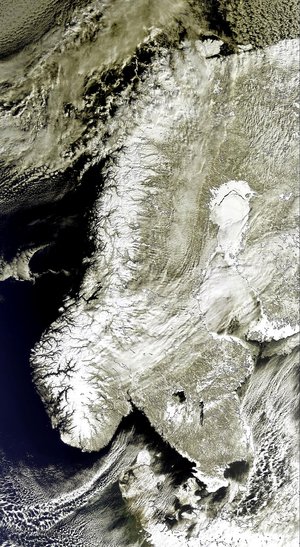Envisat helps improve safety in icy Southern Ocean
An award-winning new website is using realtime imagery from ESA's Envisat satellite to provide a wealth of information on sea ice to aid safe passage through the treacherous waters of the Antarctic.
Although remote, the Southern Ocean is an increasingly busy route for sea traffic. These seas are used more and more to conduct scientific research, transport freight, harvest fertile fishing grounds and carry tourists to experience one of Earth's last wildernesses. However, ever-changing pack ice and icebergs pose a serious danger to marine safety – as demonstrated by the loss of the MS Explorer tourist ship in 2007.

Owing to the remote and inhospitable nature of the Southern Ocean, satellite imagery offers the only real practical means of obtaining timely information on sea ice required for the safe passage of marine traffic. While safety may be a primary concern, so is cost, as sea ice can significantly delay passage times.
For some years, ESA has been providing these key data to aid navigation – but the 'Polar View' ice-monitoring service in the Antarctic has recently been greatly improved by a wealth of satellite images made accessible through a new interactive website.
Supported by ESA and the UK Foreign & Commonwealth Office, Polar View is an international consortium of companies, government agencies and research institutes that provides Earth observation services and data products for environmental monitoring and safety in the polar regions.
In this capacity, Polar View is at the forefront of providing ice-monitoring services for Europe's Global Monitoring for Environment and Security (GMES) initiative.

As part of their service on sea ice, which is coordinated by the British Antarctic Survey, the Polar View Antarctic Node website provides easy access to a multitude of realtime satellite images. Currently, these images come mainly from Envisat's Advanced Synthetic Aperture Radar, which can see through cloud and darkness to acquire the detailed images that are needed for safe and efficient shipping in this region.
The combination of up-to-date images and easy access has made this interactive website an essential tool for its growing number of users. Recognised for its excellence, the website recently won the 2010 British Cartographic Society Avenza award for electronic mapping.

"We have been able to provide information to users for the past three years, but the new website allows us to deliver much more information in a more efficient and accessible way. When you combine this with the increased amount of valuable imagery acquired by ESA we have a very powerful result," said Andrew Fleming from the British Antarctic Survey.
The website works by providing an interactive map displaying the latest satellite imagery and sea-ice information. Simple tools allow users to zoom into areas of interest and download the information they require.
Sophisticated technology also allows the high-definition images to be easily streamed to ships, even to those with low-rate Internet connections.
While Envisat is currently the main provider of images for the Polar View's website, the Sentinel satellites being developed by ESA for GMES will soon be providing more data for services in the polar regions.
In particular, Sentinel-1 will ensure a continuous supply of radar data for the next 15 years that will be used in a wide range of GMES services, including routine sea-ice mapping.
The first Sentinel-1 satellite is scheduled for launch in 2012 and will be followed by a second a few years later.















 Germany
Germany
 Austria
Austria
 Belgium
Belgium
 Denmark
Denmark
 Spain
Spain
 Estonia
Estonia
 Finland
Finland
 France
France
 Greece
Greece
 Hungary
Hungary
 Ireland
Ireland
 Italy
Italy
 Luxembourg
Luxembourg
 Norway
Norway
 The Netherlands
The Netherlands
 Poland
Poland
 Portugal
Portugal
 Czechia
Czechia
 Romania
Romania
 United Kingdom
United Kingdom
 Slovenia
Slovenia
 Sweden
Sweden
 Switzerland
Switzerland
































